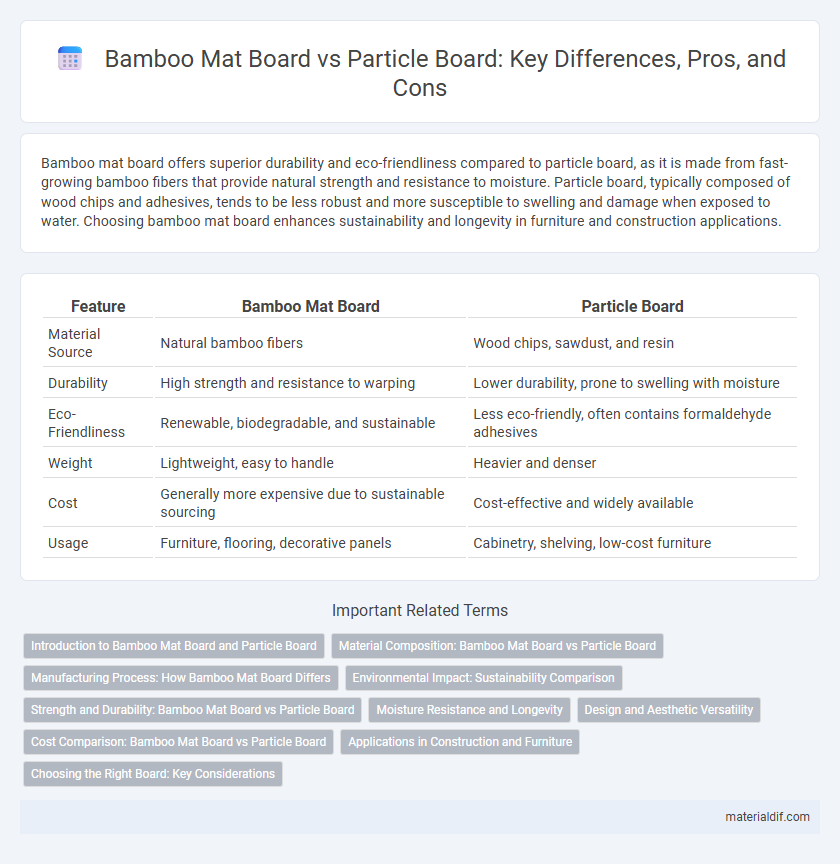Bamboo mat board offers superior durability and eco-friendliness compared to particle board, as it is made from fast-growing bamboo fibers that provide natural strength and resistance to moisture. Particle board, typically composed of wood chips and adhesives, tends to be less robust and more susceptible to swelling and damage when exposed to water. Choosing bamboo mat board enhances sustainability and longevity in furniture and construction applications.
Table of Comparison
| Feature | Bamboo Mat Board | Particle Board |
|---|---|---|
| Material Source | Natural bamboo fibers | Wood chips, sawdust, and resin |
| Durability | High strength and resistance to warping | Lower durability, prone to swelling with moisture |
| Eco-Friendliness | Renewable, biodegradable, and sustainable | Less eco-friendly, often contains formaldehyde adhesives |
| Weight | Lightweight, easy to handle | Heavier and denser |
| Cost | Generally more expensive due to sustainable sourcing | Cost-effective and widely available |
| Usage | Furniture, flooring, decorative panels | Cabinetry, shelving, low-cost furniture |
Introduction to Bamboo Mat Board and Particle Board
Bamboo mat board is an eco-friendly engineered wood product made from compressed bamboo fibers, offering excellent strength and durability with a natural aesthetic. Particle board consists of wood particles bonded with resin, providing a cost-effective and uniform surface but with lower moisture resistance and durability compared to bamboo mat board. Both materials are used in furniture and construction, though bamboo mat board is preferred for sustainable and high-strength applications.
Material Composition: Bamboo Mat Board vs Particle Board
Bamboo mat board consists of compressed layers of natural bamboo fibers, offering enhanced strength, flexibility, and eco-friendliness compared to particle board, which is made from wood chips, sawdust, and synthetic resin adhesives. The natural cellulose structure in bamboo mat board provides superior durability and resistance to moisture, whereas particle board is more prone to swelling and damage when exposed to water. Bamboo mat board's renewable bamboo source makes it a sustainable alternative with a lower environmental impact compared to particle board, which relies on recycled wood waste and synthetic binders.
Manufacturing Process: How Bamboo Mat Board Differs
Bamboo mat board is manufactured by layering and compressing woven bamboo strips, creating a dense, fibrous structure that enhances strength and flexibility. In contrast, particle board is produced by binding wood chips and resin under heat and pressure, resulting in a more uniform but less durable composition. The unique manufacturing process of bamboo mat board leverages natural bamboo fibers, offering superior resilience and environmental sustainability compared to particle board.
Environmental Impact: Sustainability Comparison
Bamboo mat board has a significantly lower environmental impact compared to particle board due to bamboo's rapid growth rate and renewable nature, allowing for quicker replenishment and reduced deforestation. Bamboo cultivation requires fewer pesticides and less water, leading to a smaller carbon footprint and less soil degradation than the wood sources typically used for particle board. In contrast, particle board relies heavily on wood waste and adhesives containing formaldehyde, resulting in higher emissions and limited sustainability.
Strength and Durability: Bamboo Mat Board vs Particle Board
Bamboo mat board exhibits superior strength and durability compared to particle board due to its dense, interwoven bamboo fibers that provide enhanced structural integrity. Unlike particle board, which often suffers from moisture absorption and swelling, bamboo mat board resists warping and maintains its shape under varying environmental conditions. This durability makes bamboo mat board a preferred choice for furniture and flooring applications requiring long-lasting performance.
Moisture Resistance and Longevity
Bamboo mat board outperforms particle board in moisture resistance due to its dense, natural fibers that repel water and reduce swelling or warping. Its longevity is significantly higher, with bamboo mat board maintaining structural integrity and appearance over time, unlike particle board, which tends to degrade and delaminate when exposed to humidity. The sustainable harvesting and rapid growth of bamboo further contribute to its durability and eco-friendly appeal in moisture-prone environments.
Design and Aesthetic Versatility
Bamboo mat board offers superior design and aesthetic versatility due to its natural grain patterns and smooth texture, which can be easily customized with stains and finishes to create unique, high-end appearances. Particle board lacks the natural beauty of bamboo and typically requires veneers or laminates to enhance its visual appeal, limiting its design flexibility. The eco-friendly nature of bamboo mat board further elevates its desirability in modern, sustainable interior design projects.
Cost Comparison: Bamboo Mat Board vs Particle Board
Bamboo mat board typically costs more than particle board due to its sustainable sourcing and durability, with prices averaging 15-30% higher per square foot. Particle board offers a budget-friendly option, often favored in low-cost furniture and cabinetry, but it tends to have lower longevity and moisture resistance. Investing in bamboo mat board provides long-term value despite the initial higher cost, as it resists warping and scratches better than particle board.
Applications in Construction and Furniture
Bamboo mat board offers superior strength, moisture resistance, and eco-friendliness compared to particle board, making it ideal for sustainable construction projects and high-quality furniture manufacturing. Its natural durability and aesthetic appeal enhance applications such as wall panels, cabinetry, and flooring, where structural integrity and design are crucial. Particle board, while cost-effective, lacks the resilience and environmental benefits of bamboo mat board, limiting its use primarily to low-load furniture and interior applications.
Choosing the Right Board: Key Considerations
Bamboo mat board offers superior sustainability and strength compared to particle board, making it ideal for eco-conscious construction and furniture applications. Particle board is generally more affordable but lacks the durability and moisture resistance found in bamboo mat board, which is crucial for long-lasting projects. Selecting the right board depends on factors such as environmental impact, load-bearing capacity, and intended use, ensuring optimal performance and cost-effectiveness.
bamboo mat board vs particle board Infographic

 materialdif.com
materialdif.com